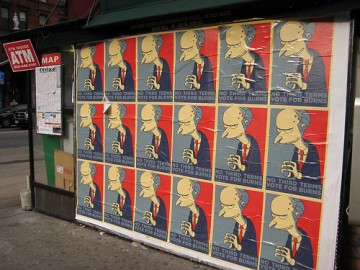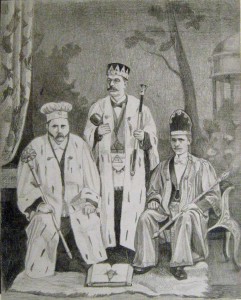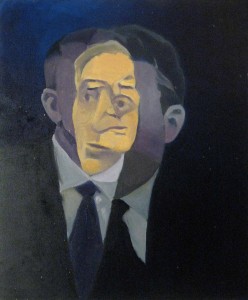To support themselves, artists typically have day jobs. While many teach, some find other ways to make ends meet. Warhol and Hopper earned money in advertising and commercial art, while Koons worked for a time as a Wall Street broker. For my inaugural guest post for Art21, I interviewed a typically silent member of the art world, an artist’s assistant. Boris Rasin is currently the assistant to a major contemporary painter and is an artist himself. Born in Kiev, Ukraine, Rasin immigrated to Brooklyn in 1991. A graduate of Manhattan’s LaGuardia High School and The Cooper Union, Rasin has dabbled in everything from drawing to video and multimedia sculpture. In this Q&A, we talk about what it’s like for him to work for an artist while being an artist himself.
Caroline Lagnado: What have some of your jobs as an artist assistant been like?
Boris Rasin: When I used to freelance, I worked for several artists in their studios, and helped several others through the galleries where they exhibited. I always liked doing these gigs. You got to hang around artists in their element, have a hand in making their work, see their quirks, etc. I especially liked seeing the art workspaces, which always give you clues about their personalities. All the gigs were different and they showed me how diverse the art world was. One moment I worked for a guy who was so broke, he shook me down for change to buy coffee; the next, I worked on a sculpture that will be sold for hundreds of thousand dollars.
CL : How does being an artist assistant jive (or not) with being an artist yourself?
BR: It definitely jives for me. I’ve picked up useful techniques and have gotten to see how people react to the pressure of deadlines and production problems. Also, it’s really inspiring to be part of the creative process.
CL: How did you get the job you have now?
BR : I worked part-time at Gavin Brown’s Enterprise for a number of years, helping them with special events, bartending, or whenever their staff was over-stretched. I became acquainted with a few of the artists that show there and one of them, my current boss, asked me if I was interested in being a personal assistant. I said yes.
CL: When do you find the time to work on your own projects?
BR: It’s tough. Between my full-time job and my personal life, there isn’t too much studio art time left. But if the motivation to work is there, you find the time. When it comes to doing site specific installations, it usually ends up with me taking time off from work and applying myself 24/7 until the job is done.
CL: How involved are you in your current boss’s paintings?
BR: Not at all. She does everything herself. My boss once asked me to gesso some canvas boards for her. They came out too messy.
CL: Besides being an artist assistant, you’ve done some collaborative work—do you prefer working in a collective or on your own? What are some differences?
BR: I have been collaborating on public art projects and site specific installations with Kenny Komer since we were students at Cooper Union. Those projects are usually super exciting and involve going to new places and meeting new people, learning about new materials, figuring out how to build stuff, etc. We try to make interactive projects so we have a specific approach to that audience.
I also draw and paint in my studio (a.k.a. my bedroom). When you work alone, you don’t have to compromise your vision and you develop a solo voice. The public, site-specific stuff is definitely a duet. I don’t prefer one to the other. It just feels great to make work.
CL: What are your influences?
BR: Besides people, movies and life in general, the biggest thing is politics. I’m a junkie. The Economist, drudgereport, New York Times, NPR, PBS. I can’t get enough of that shit. The whole news-and-infotainment universe should just be intravenously downloaded directly into my brain. Some of my recent paintings center around George W. Bush on his final day in office. Another batch is a series of paintings of Batman beating up terrorists from various news articles.
[youtube:https://www.youtube.com/watch?v=hdgjy123eJM]
CL: You co-ran a successful mock campaign in New York City’s past mayoral election—what was your experience like using art and humor to address politics?
BR: The great thing about that project was that it came at the heels of the 2008 presidential race. I spent the previous 18 months or so soaking up the coverage of the political campaigns and I really wanted to use all these ideas swirling around in my head. Luckily, there was a 2009 mayoral election in New York that was just begging for satirical commentary. Kenny [Komer] and I were working on a proposal for the public art festival, Art in Odd Places, and after a brainstorming session, we decided to have Springfield’s richest man, Mr. Burns, challenge New York’s richest, Mike Bloomberg. We were lucky enough to find an incredible voice actor, Nishan Bingham, who could mimic every character from The Simpsons and we invited some techno-wizard friends to help us edit some video clips from the cartoon that we refashioned into campaign propaganda. Then we produced a poster and sticker campaign and wild-posted parts of the city where we thought people would get the joke and spread the word. The story was picked up by a bunch of news outlets and added something to the general conversation about that election. In the end, we received a whopping 27 write-in votes.

Boris Rasin, "Monty Burns For Mayor Poster - No Third Terms - Vote For Burns" sticker, 14th Street and 7th Avenue in NYC. Via Brechtbug on Flickr.
CL: What are you working on now?
BR: For a while now I’ve had a persistent interest in secret societies and I recently decided to embrace it. I’m working on some drawings and paintings inspired by Masonic portraits and paraphernalia. I’d like to display them in a fraternal lodge.
CL: What is your dream for your future as an artist?
BR: Still figuring that out.





